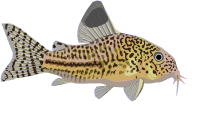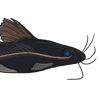Interesting pattern...
- MatsP
- Posts: 21038
- Joined: 06 Oct 2004, 13:58
- My articles: 4
- My images: 28
- My cats species list: 117 (i:33, k:0)
- My aquaria list: 10 (i:8)
- My BLogs: 4 (i:0, p:164)
- Spotted: 187
- Location 1: North of Cambridge
- Location 2: England.
Interesting pattern...
I was going through to check occurrencs records for , and once completed, the map comes out like this:
Interestingly, there isn't ANY species in the middle of the distribution range. There are a lot of newly described species from the South/East Brazil region... I wonder if the lack of "in the middle" is simply "Lack of looking".
--
Mats
Interestingly, there isn't ANY species in the middle of the distribution range. There are a lot of newly described species from the South/East Brazil region... I wonder if the lack of "in the middle" is simply "Lack of looking".
--
Mats
-
Bas Pels
- Posts: 2920
- Joined: 21 Dec 2006, 20:35
- My images: 1
- My cats species list: 28 (i:0, k:0)
- Spotted: 8
- Location 1: the Netherlands
- Location 2: Nijmegen the Netherlands
- Interests: Central American and Uruguayan fishes
Re: Interesting pattern...
Microglanis are extremely nocturnal - so lack of looking is possible
However, there are more fishes which like the coastal areas. They are especially lacking in Amazonia - well known for its extremely soft water - perhaps something they were not able to cope with?
Still a very good question - why this pattern?
However, there are more fishes which like the coastal areas. They are especially lacking in Amazonia - well known for its extremely soft water - perhaps something they were not able to cope with?
Still a very good question - why this pattern?
cats have whiskers
- Suckermouth
- Posts: 1609
- Joined: 28 Nov 2003, 14:29
- My images: 17
- My cats species list: 22 (i:0, k:0)
- My aquaria list: 2 (i:0)
- My BLogs: 6 (i:0, p:165)
- Spotted: 14
- Location 1: USA
- Location 2: Washington, DC
Re: Interesting pattern...
Another ecological reason may also be possible than habitat preference. That big middle of the range are part of the Amazon; most of the other localities appear to be non-Amazonian rivers. As the Amazon spreads across South America it brings along with it new potential competitors which may outcompete Microglanis.
Is each of these points a type locality or does it include non-type points as well? Clicking on the pointers isn't giving me any information.
Definitely an interesting pattern, but we need more info before we can say something about it.
Is each of these points a type locality or does it include non-type points as well? Clicking on the pointers isn't giving me any information.
Definitely an interesting pattern, but we need more info before we can say something about it.
- Milton Tan
Research Scientist @ Illinois Natural History Survey
Research Scientist @ Illinois Natural History Survey
- MatsP
- Posts: 21038
- Joined: 06 Oct 2004, 13:58
- My articles: 4
- My images: 28
- My cats species list: 117 (i:33, k:0)
- My aquaria list: 10 (i:8)
- My BLogs: 4 (i:0, p:164)
- Spotted: 187
- Location 1: North of Cambridge
- Location 2: England.
Re: Interesting pattern...
They are occurrence & type localities. I have as a plan to use different markers for each, but you can figure out which is which by hovering over the marker - if it says "Tuy Microglanis iherengi", then it's an occurrence [in Rio Tuy], if it just says a species name, then it's a type locality. [Assuming you go to the Cat-eLog page for the genus, of course - the map above is just a screenshot]
I think it's possible, however, that there is one species listed as "Amazon", and htat species is quite widespread - the way our occurrence records work doesn't show every place it may be, if it's listed as "Widespread in Amazon Basin", it just gets one marker at "middle of Amazon river", even if it actually lives in Rio Negro and Rio Tapajos, etc. But I would have expected at least one or two species in the middle reaches of the Amazon...
--
Mats
I think it's possible, however, that there is one species listed as "Amazon", and htat species is quite widespread - the way our occurrence records work doesn't show every place it may be, if it's listed as "Widespread in Amazon Basin", it just gets one marker at "middle of Amazon river", even if it actually lives in Rio Negro and Rio Tapajos, etc. But I would have expected at least one or two species in the middle reaches of the Amazon...
--
Mats
- Silurus
- Posts: 12479
- Joined: 31 Dec 2002, 11:35
- I've donated: $12.00!
- My articles: 55
- My images: 903
- My catfish: 1
- My cats species list: 90 (i:1, k:0)
- Spotted: 433
- Location 1: Singapore
- Location 2: Moderator Emeritus
Re: Interesting pattern...
The map in here shows additional records of Microglanis somewhere nearer the center.

- MatsP
- Posts: 21038
- Joined: 06 Oct 2004, 13:58
- My articles: 4
- My images: 28
- My cats species list: 117 (i:33, k:0)
- My aquaria list: 10 (i:8)
- My BLogs: 4 (i:0, p:164)
- Spotted: 187
- Location 1: North of Cambridge
- Location 2: England.
Re: Interesting pattern...
I don't see huge difference - the only difference between that map and mine is that it shows some of the exact capture locations, where mine are "the river(system) they come from", which may not be quite the same thing. There's still a huge hole all around the Amazon basin proper. There are some at the extended upper reaches of the Amazon, and there are some at the extreme upper range of Rio Tocantins, which may be consered an "Amazon basin" river (we do have it as a "flows into the Amazon", I think).Silurus wrote:The map in here shows additional records of Microglanis somewhere nearer the center.
Either way, I just thought it was an interesting observation.
--
Mats
-
Bas Pels
- Posts: 2920
- Joined: 21 Dec 2006, 20:35
- My images: 1
- My cats species list: 28 (i:0, k:0)
- Spotted: 8
- Location 1: the Netherlands
- Location 2: Nijmegen the Netherlands
- Interests: Central American and Uruguayan fishes
Re: Interesting pattern...
Correct me if I'm wrong, but the Poecilia family - lifebearers - have more or less a similar distribution: Central America, the north coast of south America and in the Rio de la Plata region.
None in Amazonia
the same goes for the Anablepidae, one sided lifebearers: Anableps in Panama and north South America, Jenynsia in the south
Again, none in Amazonia
The Heroine cichlids (Heros, Mesonauta, discus, Thoricythys, Australoheros) are devided into 2 groups - the Heroine sens stricto (the 3 first genera I mentioned)) and the Heroine sensu lato (the las 2 genera I mentioned) - the first are only found in Amazonia, the latter in central America, and the Rio de la Plata region.
Perhaps there is something with Amazonia....
None in Amazonia
the same goes for the Anablepidae, one sided lifebearers: Anableps in Panama and north South America, Jenynsia in the south
Again, none in Amazonia
The Heroine cichlids (Heros, Mesonauta, discus, Thoricythys, Australoheros) are devided into 2 groups - the Heroine sens stricto (the 3 first genera I mentioned)) and the Heroine sensu lato (the las 2 genera I mentioned) - the first are only found in Amazonia, the latter in central America, and the Rio de la Plata region.
Perhaps there is something with Amazonia....
cats have whiskers





